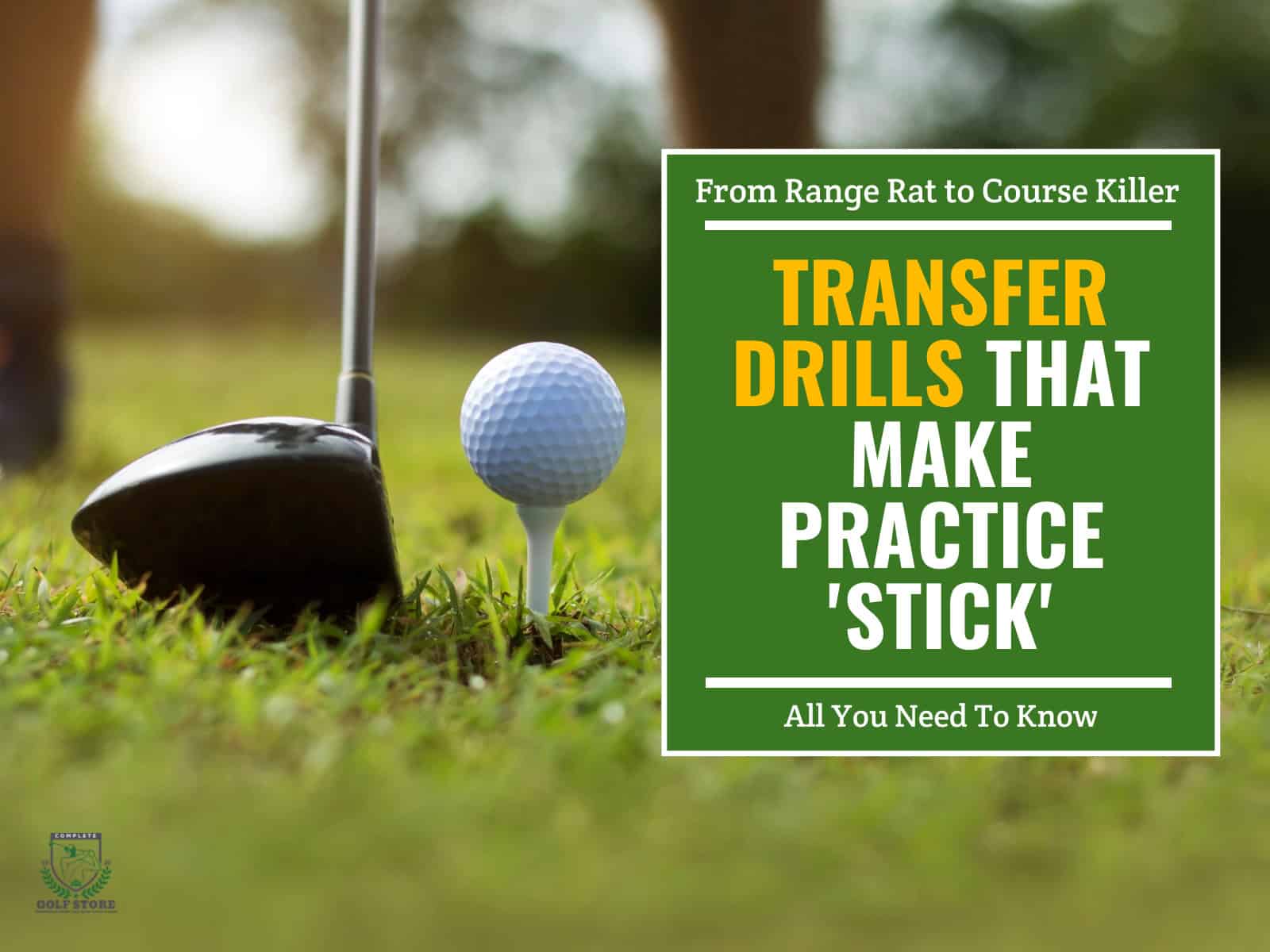Playing is practicing. Yet you get better faster when you split limited hours between rounds that reveal problems and drills that fix them. You don’t need a tour van, just a clear plan and honest notes after each outing.
So here’s the promise: you’ll get simple, no-nonsense golf practice schedules that fit real life. You choose a goal: break 100, break 90 or break 80, and a weekly time budget of 5, 7 or 10 hours. Then you follow a clean path that tells you what to do, when to play and where to point your effort.
And yes, the approach stays flexible, as you can tune it week by week as your ball flight and scorecard talk back. You’ll know exactly how to spend your next hour, whether it’s on the course or on a short, focused drill.
- 1) Quick Answer: Practice vs. Play Split at a Glance
- 2) Why Practice vs. Play Balance Matters
- 3) 5-Hour Golf Week: Schedules by Handicap Goal
- 4) 7-Hour Golf Week: Schedules by Handicap Goal
- 5) 10-Hour Golf Week: Schedules by Handicap Goal
- 6) On-Course Practice Methods That Work
- 7) High-Impact Drills (Simple, Purposeful, Repeatable)
-
8)
Frequently Asked Questions
- 8.1) How often should I take lessons within a 10-hour week?
- 8.2) Can I reach single digits mostly by playing if I have course access daily?
- 8.3) What’s a realistic 60-minute “all-in-one” session on busy days?
- 8.4) How do I know when to advance my goal from break 90 to break 80?
- 8.5) What if I don’t have a range—can I still improve?
- 8.6) How should I adapt in the off-season or during travel?
- 8.7) How do I track progress without getting lost in swing thoughts?
- 9) Final Thoughts
Quick Answer: Practice vs. Play Split at a Glance
Start simple: play to spot leaks, practice to plug them. Use one rule: if contact and start line are steady, go play; if they wander, shift time to drills.
5-hour week
- Default: 40% practice / 60% play
- If ball-striking slips: 60% practice / 40% play
- One note: after each round, write the single biggest leak and make the next session fix that — no extras.
7-hour week
- Default: 50% practice / 50% play
- Flex week: poor contact → 70% practice; clean contact with blowups → 70% play
- One note: change the split once per week, not mid-week.
10-hour week
- Default: 50% practice / 50% play
- Built-in check: one scored round, one “test” round where you try shots you’ll need under heat
- One note: if three-putts stay high, steal 1 hour from long game to short game and watch the card react.
Why Practice vs. Play Balance Matters
You get better at golf by seeing where the cracks show up. A round under real pressure will expose them faster than any drill. Then practice gives you the tools to patch those cracks. It’s a rinse-and-repeat cycle: play, spot the leak, fix it, and test again.
Range time is useful only if it has a target. Hitting a hundred balls with no plan is just exercise. If you’re chasing a number like breaking 90, every swing on the range needs a purpose, be it distance control, ball flight or contact. That’s how you turn time into progress.
However, the range doesn’t always transfer. You might stripe it on the mat and then push shots wide on the course. That gap is real, and the only way to close it is to rehearse new skills on real holes with real stakes. So the balance matters; without it, you’ll always feel like two different golfers.
5-Hour Golf Week: Schedules by Handicap Goal
Five hours is enough to see progress if you spend them wisely. The key is balance: play to test yourself, practice to fix what breaks, then repeat. Here’s how to split those hours based on your target.

Break 100 — Simple, Score-First Golf Practice Schedule
Spend 2 hours playing 9 holes with a focus on “fairway-first.” Choose clubs that keep the ball in play, even if it means leaving the driver in the bag.
Use 1.5 hours on the short game. Roll 3–6 footers and lag putts for 45 minutes, then chip and pitch to landing spots for 45 minutes.
Finish with 1.5 hours on full swing basics. Work on solid contact with a mid-iron or hybrid. Use alignment sticks to stay square.
The goal is fewer penalties and fewer three-putts.
Break 90 — Practice vs Play Golf Split with Purpose
Spend 3 hours playing 18 holes or two 9s. Track fairways, greens and putts. On three tough holes, play two balls with different targets.
Use 2 hours on short game. Build a wedge matrix with half, three-quarter and full swings. Add bunker work and finish with 15 minutes of pressure putts.
Spend 2 hours on full swing. Begin with mid-irons for accuracy, then move to drivers aimed at fairway windows.
Your objective is to stop doubles, control wedges and steady the putter.
Break 80 — Compact, Competitive Break 80 Plan
Play 2.5–3 hours on the course. One competitive 18 with full routine and scoring goals, plus one 9-hole skills round without a card—focus on shaping shots.
Dedicate 2–2.5 hours to the short game. Run up-and-down circuits, practice long lag putts and hit bunker shots to tight pins.
Finish with 1.5–2 hours on long game drills. Use the 9-ball drill for shaping, and gates for start lines and trajectory.
You want to eliminate big misses and sharpen scoring shots inside 100 yards.
7-Hour Golf Week: Schedules by Handicap Goal
Seven hours gives you more room to breathe. You can fit a full round, some range time and enough short game work to see clear progress. The trick is balancing structure with flexibility so you don’t waste swings.

Break 100 — Confidence + Contact
Play 3 hours on the course with 18 holes. Add three “replay” holes where you hit the same shot twice to learn recovery.
Use 2 hours on short game. Practice putting start lines and distance control, then basic chips and pitches.
Finish with 2 hours full swing. Work from short swings into longer ones to find the center of the clubface.
Focus on steady contact and confidence.
Break 90 — Balanced, Data-Driven
Spend 3 hours playing 18 holes. Warm up 20 minutes before and write 10 minutes of notes after.
Dedicate 2 hours to short game. Map wedge distances and add bunker and rough practice.
Use 2 hours for full swing. Train a fairway-finder driver and green-hitting mid-irons.
Focus on better decisions backed by data.
Break 80 — Pressure & Precision
Play 3–3.5 hours on course. Do one “score” round with full focus and one practice round using two balls for different shot shapes.
Commit 2 hours to short game. Run up-and-down tests and make pressure putts inside 6 feet.
Use 1.5–2 hours for full swing. Build consistency with start-line gates, curvature drills and swing speed checks.
Focus on precision under pressure, and knowing whether you can trust it when it counts.
10-Hour Golf Week: Schedules by Handicap Goal
Ten hours gives you enough time to mix full rounds with structured practice. With this much space, you can polish weak spots while still playing enough to see how changes hold up under pressure.

Break 100 — Build Repeatability
Play 4 hours on the course. One full 18 plus a quick 9. Stick to safe targets to avoid penalties.
Use 3 hours on short game. Split evenly between putting, chipping, pitching, and bunker basics.
Spend 3 hours on full swing. Work on rhythm and clean contact with hybrid and 7-iron.
Your focus should be on building a repeatable swing and cutting down big misses.
Break 90 — Structured Variety
Play 4–4.5 hours. Include one full round and replay trouble shots after finishing holes.
Dedicate 2.5–3 hours to short game. Practice wedges under fatigue and bunker distance control.
Use 2–2.5 hours on full swing. Train driver dispersion and mid-iron pin-high accuracy.
Focus on consistent scoring across all clubs.
Break 80 — Tournament-Style Rhythm
Play 4 hours. One round should be competitive with full routine; the other a 9-hole test loop.
Commit 3 hours to short game. Focus on advanced wedges with spin and trajectory, plus tough lies like downhill and sidehill.
Finish with 3 hours on full swing. Run the 9-shot drill, keep speed up and create tee-ball plans for different holes.
You must focus on sharpening tournament habits—and seeing if you can handle the heat when it matters most.
On-Course Practice Methods That Work
The course itself can be your best training ground. Ranges are useful, but they rarely recreate the pressure and decisions you face hole after hole. When you use your rounds as part of practice, you make drills more realistic and see faster progress.

Blending Practice Into Rounds
Instead of treating every round like a tournament, turn some into experiments. Play two balls with different shapes—maybe a cut with one, a draw with the other—and see which strategy holds up better. You’ll learn what shots fit your eye and which ones feel forced.
Pressure can also be built in. Give yourself an up-and-down challenge where a failed attempt means repeating until you pass. Or, on the green, re-putt a miss from the same spot until you make it. The pass-or-fail setup makes the stakes real, even when no scorecard is on the line.
Weekly Ratio Tweaks (Dynamic Split)
Your split between practice and play shouldn’t be set in stone. If your ball-striking drifts, swing the ratio toward practice—sometimes as much as 80% for a week. Work through drills until you feel the strike return.
When contact is steady and scores trend down, flip the ratio toward play. Spend more time on the course applying those swings in real situations. Think of it as steering a ship: small weekly adjustments keep you on course.
High-Impact Drills (Simple, Purposeful, Repeatable)
You don’t need fancy tools or endless hours to sharpen your game. What you need are drills that bite: simple enough to repeat, tough enough to make you better. These cover the short game, full swing and putting.

Short Game
A lag ladder teaches feel. Drop three balls at 20, 40, and 60 feet. The goal is to stop each one inside 10% of the distance. Miss, and you start again.
Landing-spot chips change how you see the green. Pick three landing zones short, middle, and long of the pin. Chip to those spots instead of the hole. Rotate lies, and you’ll learn how to control roll.
Bunker basics mean no excuses. Use one club only and focus on clean exits. Once you’re steady, add distance windows (short, medium, long) to test your control.
Full Swing
The center-strike ladder builds consistency. Start with a waist-high swing, then chest-high, then full. Focus on center contact at each stage. Alignment sticks help check face and path.
For players working on takeaway fundamentals, using alignment sticks to improve your takeaway adds structure to practice.
Start-line gates force accountability. Place two tees a few feet in front of you, creating a narrow corridor. The ball must launch between them. Any curve after is fine, but your start line tells the truth.
The 9-shot drill is your creativity test. Hit three heights (low, mid, high) with three shapes (draw, straight, fade). That’s nine ball flights with your stock clubs. It’s the fastest way to find control you didn’t know you had.
Putting
The start-line gate drill makes short putts automatic. Place two tees at the width of a ball a foot in front of you. Sink 20 in a row from 3–6 feet before leaving.
Distance ladders cure three-putts. Hit six putts each from 20, 30 and 40 feet. The challenge is to make two-putt or better every time.
A pressure finish seals practice. Stand at 5 feet. Make five in a row. Miss one, start over. You’ll walk off the green knowing what nerves feel like, and how to beat them.
Frequently Asked Questions
Everyone runs into the same doubts when trying to balance practice and play. We provided answers to clear up the most common sticking points so you can stay focused on steady improvement.
How often should I take lessons within a 10-hour week?
Dedicate about an hour every one to two weeks with a coach. Use the sessions to set homework that keeps your practice targeted.
Can I reach single digits mostly by playing if I have course access daily?
Yes, frequent play can get you there. Just add short, focused sessions to work on weaknesses you spot during rounds.
What’s a realistic 60-minute “all-in-one” session on busy days?
Split it evenly: 20 minutes on a putting ladder, 20 minutes with wedge distance control and 20 minutes using start-line gates with a mid-iron.
How do I know when to advance my goal from break 90 to break 80?
You’re ready when double bogeys are rare, three-putts are under one per round and approach shots leave frequent up-and-down chances.
What if I don’t have a range—can I still improve?
Yes. Use the course itself to practice: hit two balls, replay tricky shots and build strike quality with at-home putting or chipping.
How should I adapt in the off-season or during travel?
Keep a daily 15–20 minute “vitamin” routine: a putting mat, contact drills or mirror work to stay sharp.
How do I track progress without getting lost in swing thoughts?
Log fairways, greens and putts. Note one weakness per round. Build your next week’s practice around that single limiter.
Final Thoughts
Golf progress comes from balance. Playing shows you weaknesses, while practice gives you the tools to fix them. Without both, your game stalls.
The 5-, 7- and 10-hour schedules are flexible roadmaps. Shift practice or play depending on where your game needs work.
Always give priority to the short game. Putting inside six feet, consistent chips and reliable bunker play save strokes faster than any swing tweak.
Keep practice simple, repeatable and tied to real on-course feedback. Play to test, practice to sharpen, then return to the course to measure results. The real key is adjusting the split each week so progress never slows.
Another often-overlooked key to consistency is alignment. Learning how to properly line up a golf shot ensures that practice gains translate to the course, helping you start every swing on target.





